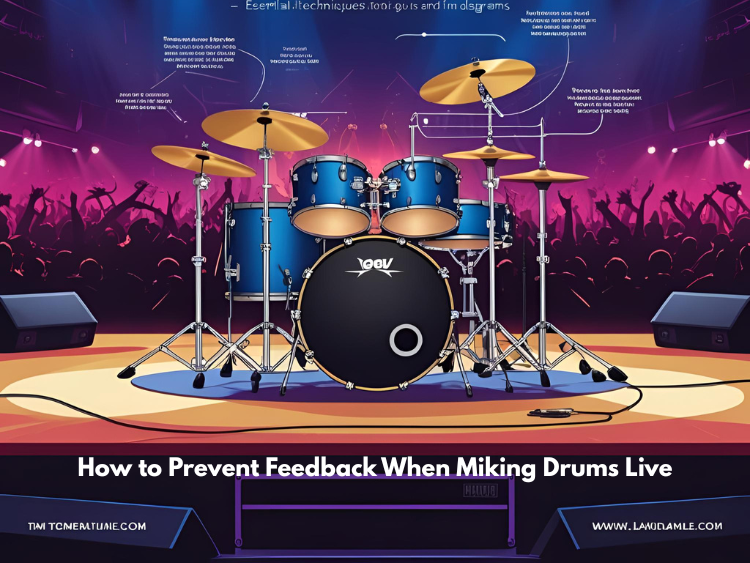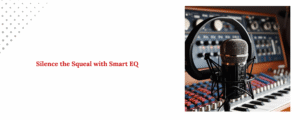Live music concerts really come alive because of the drums. Dancing is more likely when your drum sound is clear, strong and balanced. A major challenge is controlling the noise that comes from the surrounding area during live performances. Feedback affects the audience, and it also makes the professional’s job more demanding. There are a number of techniques you can use to stop feedback while using a mic during a drum performance that this article will illustrate. It will make sure your drum sound remains free of disturbing feedback and is always very strong.
How to Understand Feedback
Before looking for methods to stop it, it helps to first learn about feedback. When the sound from speakers goes to the microphone, gets amplified and is played back again through the speakers, this is called feedback. The annoying high-pitched noise or screaming is produced by the loop, which makes the pitch rise quickly.
- Problems can become worse when drums are part of the music.
- Drums are capable of emitting a lot of noise and a variety of tones.
- When more than one microphone is used, the chance of mic bleed increases.
- During a concert, there are many sound sources and reflective surfaces.
So, considering this, here’s what you should do about feedback.
Make Use of Directional Microphones
Picking out the right drum microphones is one of the easiest ways to stop noise. The Cardioid or supercardioid microphones are directional and receive primarily the sound in front and disregard the surrounding and rear sound.
- Close-mike with directional mics: Place the directional mics near the snare, tom and the kick to pick up clear sound and avoid background noise.
- Use supercardioid or hypercardioid overhead mics: These will be pointed at the drums and will help to reject monitors and PA speaker sound.
Directional mics reduce the level of the raised sound entering the mic, and hence, the possibility of feedback is reduced.
Find the Best Place for the Microphone
Mic placement is key to reducing feedback:
- Get the mics closer to the drums in order to avoid echo, and less gain may be applied.
- Do not set mics towards monitors or speakers, as it would result in a loop of sound.
- Do beware of overhead mics: do not point them at reflective surfaces or at speakers.
- Ask the sound engineer to test positions and distances of all angles to get the best results during sound checks.
Set the Levels and Placement of the Stage Monitors
When drums are played live, stage speakers can cause a lot of noise. To cut down on monitor feedback:
- Use in-ear monitors (IEMs) if possible: Without boosted sound moving around, IEMs almost completely get rid of stage monitor noise.
- If you need floor monitors, place them in convenient spots: Keep speakers away from drum mics, either behind or to the side of them.
- Keep the stage monitor volume as low as possible. Lowering the sound of the stage monitors makes feedback loops less likely.
- Ask players to wear in-ear monitors or headphone mixes to eliminate the use of loudspeakers on the stage.
Use the Right EQ and Notch Filtering
Equalization (EQ) is a powerful tool for controlling feedback:
- Cut frequencies that are causing problems: Use a graphic or adjustable EQ to find frequencies that cause feedback and lower them.
- Use notch filters: Narrow notch filters can precisely find the frequency of feedback and cut it out without changing the overall sound quality.
- Carefully boost: Don’t boost the frequencies in the drum mix too much, as this can make echoes more likely.
- Slowly turn up the volume during soundcheck and listen for feedback frequencies to fade out.
Take Care of the Gain Structure and Don’t Overload
The key is to stage gains correctly:
- Pick the right strength for the microphone preamp: If you have too much gain, the risk of echo goes up; if you have too little gain, the sound is less clear.
- The idea is to have a punchy but tidy signal. Increase the gain only so that a bold signal is obtained which does not clip or distort.
- Never overload the PA input channels because they can cause distortion which initiates feedback.
- Carefully balance the strength of each mic during soundcheck, and keep an eye on the levels during the show.
Keep Background Noise and Stage Reflections to a Minimum
The environmental things influence feedback:
- Absorb sound: foam or curtains around the drum kit absorb much of the sound and any echoes.
- Avoid reflecting objects: Glass or metal sheets that are large around the drum set can make the sound bounce in opposite directions, which may result into feedback.
- Regulate the stage level: In order to avoid the sound accumulating to a loud level, maintain the overall stage level to an acceptable level.
Minor variations of the environment can also render issues of feedback much less probable.
Conclusion
Feedback avoidance in drum recording requires deploying the right equipment, positioning mikes in the right positions, monitoring a stage sound and applying audio processing respectively. Keeping good, powerful sound can be helped by studying the effect of feedback to your drumming and correct your set up before hand. Variations in all the spaces thus remain open to various variations, perfect them, and keep giving the music a good feeling even in so-called sound checks.




